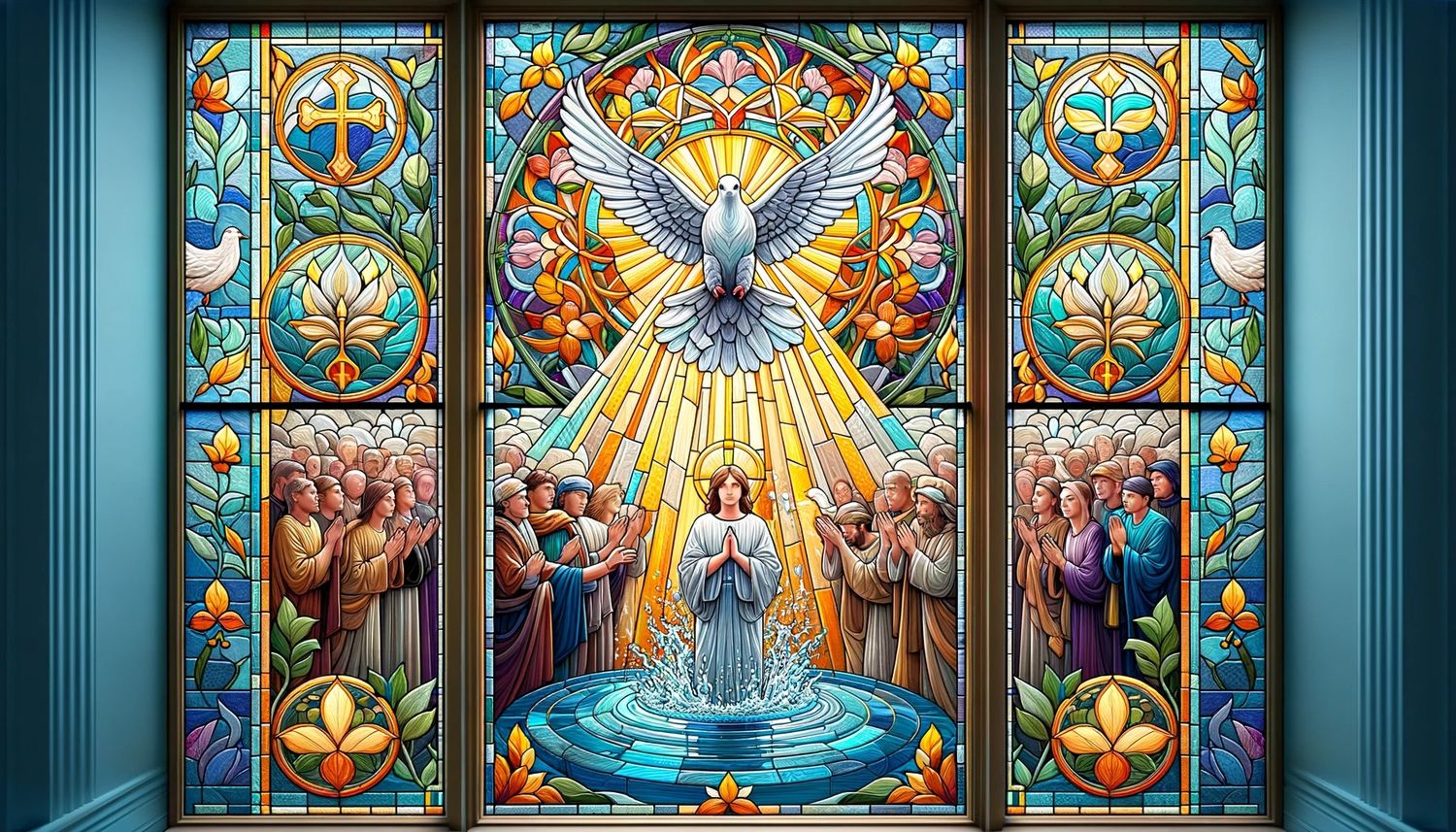Home>Theology and Spirituality>How To Do A Baptism


Theology and Spirituality
How To Do A Baptism
Published: March 2, 2024
Ericka Andersen, an editor at Christian.net, expertly merges digital strategy with content creation, focusing on faith and societal issues. Her communication skills enhance the platform's engaging narratives, fostering meaningful dialogue on belief's impact on society.
Learn the significance and process of baptism in theology and spirituality. Discover how to perform a baptism ceremony and its spiritual importance.
(Many of the links in this article redirect to a specific reviewed product. Your purchase of these products through affiliate links helps to generate commission for Christian.net, at no extra cost. Learn more)
Table of Contents
Understanding the Significance of Baptism
Baptism is a sacred and symbolic ritual that holds great significance in many religious traditions. It is a rite of passage that marks the initiation of an individual into the faith community and symbolizes purification, renewal, and the washing away of sins. The act of baptism is deeply rooted in spiritual and religious beliefs, and it is considered a fundamental step in the journey of faith for many people. Whether it is through the sprinkling of water, immersion in a body of water, or anointing with oil, baptism is a powerful and meaningful ceremony that carries profound spiritual significance for individuals and their families. It is a public declaration of one's commitment to their faith and a symbol of their acceptance into the religious community.
Read more: How Do Presbyterians View Baptism
Reasons for Baptism
- Spiritual Cleansing: Baptism is often viewed as a spiritual cleansing, where the individual is symbolically washed of their sins and welcomed into the faith community.
- Initiation into the Faith: It serves as a formal initiation into the religious community, signifying the individual's acceptance of the beliefs and practices of the faith.
- Symbol of Renewal: Baptism represents a spiritual rebirth and renewal, marking the beginning of a new life dedicated to the principles and teachings of the faith.
- Public Declaration of Faith: It is a public declaration of one's commitment to their faith and a symbol of their acceptance into the religious community.
Symbolism of Baptism
- Purification: The act of being immersed in water or having water sprinkled symbolizes purification and the cleansing of sins.
- New Life: Baptism is often associated with the idea of being born again, symbolizing a new life and a fresh start in the individual's spiritual journey.
- Union with Christ: In Christian traditions, baptism is seen as a way of uniting with the death and resurrection of Jesus Christ, signifying a spiritual union with the divine.
Importance in Different Religions
- Christianity: In Christianity, baptism is considered a sacrament and is seen as an essential step in the process of salvation and entry into the Christian community.
- Judaism: In Judaism, ritual immersion, known as mikvah, is practiced for various purposes, including conversion, purification, and spiritual renewal.
- Islam: While not a formal ritual in the same sense as in Christianity and Judaism, ablution (wudu) is an important cleansing ritual before prayer in Islam, symbolizing purification and spiritual readiness.
Understanding the significance of baptism helps individuals and families appreciate the spiritual and symbolic depth of this sacred ritual, making it a meaningful and profound experience in their religious journey.
Preparing for the Baptism Ceremony
Preparing for a baptism ceremony involves careful planning and thoughtful consideration to ensure that the event is meaningful and memorable for the individual being baptized and their loved ones. It is a time-honored tradition that calls for attention to detail and a focus on creating a spiritually enriching experience. Here are the essential steps to prepare for a baptism ceremony:
-
Consult with Religious Leaders: Before the baptism, it is important to consult with the appropriate religious leaders or clergy members to understand the specific requirements and customs associated with the baptism ceremony. They can provide guidance on the necessary preparations and any religious or cultural traditions that should be observed.
-
Select Godparents or Sponsors: In many religious traditions, the selection of godparents or sponsors is a significant aspect of the baptism ceremony. These individuals play a crucial role in the spiritual upbringing of the baptized person and may have specific responsibilities during the ceremony. Carefully choosing godparents who are committed to supporting the individual's faith journey is an important part of the preparation process.
-
Coordinate with the Church or Place of Worship: If the baptism is to take place in a church or place of worship, it is essential to coordinate with the appropriate authorities to secure the date and time for the ceremony. This may also involve arranging for any necessary religious items, such as baptismal fonts, candles, or other ceremonial objects.
-
Prepare the Necessary Documents: Depending on the religious tradition, there may be specific documents or forms that need to be completed before the baptism can take place. This could include a formal application for baptism, proof of eligibility for the sacrament, or other administrative requirements. Ensuring that all necessary paperwork is in order is an important part of the preparation process.
-
Plan the Order of the Ceremony: Work with the religious leaders or clergy to plan the order of the baptism ceremony. This may include selecting readings, prayers, and other elements of the service that hold personal significance for the individual and their family. Taking the time to personalize the ceremony can make it a more meaningful and memorable experience.
-
Arrange for Baptismal Garments and Accessories: Depending on the religious tradition, there may be specific garments or accessories associated with the baptism ceremony. This could include a baptismal gown, a christening outfit, or other symbolic items that are worn during the ceremony. Ensuring that these items are prepared and ready for the day of the baptism is an important part of the overall preparation process.
By carefully preparing for the baptism ceremony, individuals and their families can ensure that the event is a spiritually enriching and memorable experience that reflects the significance of this sacred ritual.
Read more: How Do You Wish For Baptism
Choosing the Right Location for Baptism
Selecting the right location for a baptism is a crucial aspect of the planning process, as it sets the stage for the sacred and meaningful ceremony. The choice of location can significantly impact the overall atmosphere and experience of the baptism, so careful consideration is essential. Here are some key factors to consider when choosing the right location for a baptism:
-
Religious Venue: Many baptisms take place in a church or place of worship that holds significance within the religious tradition. These venues often have designated areas for baptism, such as a baptismal font or pool, and provide a spiritually rich and reverent setting for the ceremony. The religious venue also allows for the participation of clergy members and the incorporation of religious customs and traditions into the baptism.
-
Natural Settings: Some families may choose to have the baptism in a natural setting, such as a river, lake, or beach, particularly if the religious tradition emphasizes the symbolism of water in the baptismal rite. Natural settings can provide a serene and picturesque backdrop for the ceremony, allowing for a connection with the elements and the beauty of the natural world.
-
Home or Private Residence: For a more intimate and personal experience, some families opt to have the baptism at home or in a private residence. This allows for a close gathering of family and friends in a familiar and comfortable environment, creating a warm and welcoming atmosphere for the ceremony.
-
Community Centers or Event Spaces: In some cases, families may choose to hold the baptism in a community center or event space that can accommodate a larger gathering of guests. These venues offer flexibility in terms of space and amenities, allowing for the customization of the ceremony and the convenience of hosting a reception or gathering following the baptism.
-
Historical or Cultural Sites: Depending on the family's heritage and cultural background, they may choose to have the baptism at a historical or cultural site that holds significance to their identity and traditions. This could include landmarks, heritage sites, or locations of historical importance within their community or cultural heritage.
-
Consider Accessibility and Amenities: When selecting a location for the baptism, it is important to consider the accessibility of the venue for all guests, including those with mobility needs. Additionally, ensuring that the chosen location has the necessary amenities, such as restroom facilities, seating, and parking, is essential for the comfort and convenience of all attendees.
By carefully considering these factors, families can choose a location for the baptism that aligns with their religious beliefs, personal preferences, and the overall significance of the ceremony, creating a memorable and spiritually enriching experience for all involved.
Selecting a Baptismal Gown or Outfit
Selecting the perfect baptismal gown or outfit is an essential part of preparing for the baptism ceremony. The baptismal attire holds symbolic significance and serves as a visual representation of the individual's commitment to their faith. When choosing a baptismal gown or outfit, several factors should be taken into consideration to ensure that it aligns with the religious traditions and personal preferences of the individual and their family.
Traditional vs. Modern Styles
Families may choose between traditional and modern styles of baptismal gowns or outfits. Traditional gowns often feature intricate lace, embroidery, and long flowing designs, symbolizing purity and the sacred nature of the ceremony. On the other hand, modern outfits may include simpler, contemporary designs that reflect personal taste while still honoring the solemnity of the occasion.
Symbolic Colors and Fabrics
The color and fabric of the baptismal gown or outfit often carry symbolic meaning. White is a common choice, symbolizing purity, innocence, and the cleansing of sins. Other pastel colors may also be chosen to represent joy, new life, and the celebration of the individual's initiation into the faith community. Fabrics such as silk, satin, or cotton are popular choices for their comfort and elegance.
Read more: What Do You Do After Baptism
Cultural and Religious Traditions
The selection of the baptismal gown or outfit may be influenced by cultural and religious traditions. Different religious denominations and cultural backgrounds may have specific guidelines or customs regarding the style, color, and design of the baptismal attire. It is important to consider these traditions and ensure that the chosen gown or outfit respects and aligns with the religious and cultural significance of the ceremony.
Personalization and Heirlooms
Some families choose to personalize the baptismal gown or outfit by incorporating meaningful details, such as embroidery, monograms, or family heirlooms. This adds a personal touch and creates a cherished keepsake that can be passed down through generations, carrying the memories and blessings of the baptism ceremony.
Comfort and Practicality
In addition to its symbolic significance, the baptismal gown or outfit should be comfortable and practical for the individual being baptized. Consideration should be given to the fabric's breathability, ease of movement, and the overall comfort of the attire, especially if the baptism involves immersion in water or other physical aspects.
Sustainability and Ethical Considerations
For families concerned with sustainability and ethical practices, choosing a baptismal gown or outfit made from eco-friendly, organic, or ethically sourced materials may be a priority. This reflects a commitment to environmental stewardship and ethical consumerism while honoring the sacredness of the baptism ceremony.
By carefully considering these factors, families can select a baptismal gown or outfit that not only adheres to religious and cultural traditions but also reflects the individual's personal journey of faith, creating a meaningful and visually impactful element of the baptism ceremony.
Read more: What Does Baptism Do
Inviting Family and Friends to the Baptism
Inviting family and friends to the baptism is a significant aspect of the preparation process, as it allows loved ones to share in the joyous and sacred occasion. The presence of family and friends not only provides support and encouragement to the individual being baptized but also creates a sense of community and togetherness during this important milestone in their spiritual journey. Here are essential considerations for inviting family and friends to the baptism:
Determine the Guest List
Begin by determining the guest list for the baptism. This may include close family members, extended relatives, friends, and members of the religious community. Consider the capacity of the chosen location and the preferences of the individual and their family when compiling the guest list.
Send Invitations in Advance
Once the guest list is finalized, send out invitations well in advance of the baptism date. This allows guests to mark their calendars and make any necessary arrangements to attend the ceremony. Traditional paper invitations or digital invitations via email or social media can be used to ensure that all invited guests receive the details of the event.
Include Relevant Information
The invitations should include all relevant information, such as the date, time, and location of the baptism, as well as any specific instructions or requests, such as dress code or cultural customs that guests should be aware of. Providing clear and comprehensive details helps guests prepare for the ceremony and ensures a smooth and organized event.
Read more: How To Conduct A Baptism?
Personalize the Invitations
Consider personalizing the invitations to reflect the significance of the occasion. Including a heartfelt message or a brief explanation of the importance of the baptism can add a personal touch and convey the spiritual significance of the event to the invited guests.
Coordinate with Godparents and Sponsors
If the baptism involves godparents or sponsors, coordinate with them to ensure that they are actively involved in the invitation process. They may play a role in inviting their own family and friends to witness and participate in the baptism, further expanding the circle of support and community around the individual being baptized.
Plan for Post-Baptism Celebrations
In addition to the ceremony, consider planning post-baptism celebrations or gatherings to further engage family and friends in the joyous occasion. This could include a reception, a meal, or a simple gathering to share in the celebration and fellowship following the baptism.
Express Gratitude and Appreciation
As part of the invitation process, express gratitude and appreciation to the invited guests for their presence and support. Acknowledge the significance of their participation in this important moment and convey the value of their presence in the individual's spiritual journey.
By thoughtfully inviting family and friends to the baptism, individuals and their families can create a warm and inclusive atmosphere that honors the sacredness of the occasion and allows loved ones to share in the spiritual significance of the ceremony.
Read more: How To Prepare For Baptism
Conducting the Baptism Ceremony
Conducting the baptism ceremony is a sacred and solemn responsibility that requires careful planning, reverence, and attention to the spiritual significance of the ritual. Whether performed by clergy members, religious leaders, or designated officiants, the baptism ceremony holds deep symbolic meaning and serves as a pivotal moment in the individual's spiritual journey. Here are the essential elements involved in conducting a baptism ceremony:
Preparation and Rehearsal
Before the actual ceremony, it is crucial to prepare and rehearse the various components of the baptism. This may include coordinating with the individual being baptized, their family, and any participants or sponsors involved in the ceremony. Rehearsing the order of the service, the readings, prayers, and any symbolic actions ensures a smooth and reverent execution of the baptism.
Setting the Atmosphere
Creating a reverent and spiritually enriching atmosphere is essential for the baptism ceremony. Whether held in a church, natural setting, or private residence, the ambiance should reflect the sacredness of the occasion. This may involve the use of candles, religious symbols, and appropriate decor to set the tone for the ceremony.
Invocation and Blessings
The ceremony typically begins with an invocation, where the officiant or clergy member calls upon the divine presence and offers blessings for the individual being baptized. This sets the spiritual tone for the ceremony and invokes the guidance and grace of the divine throughout the ritual.
Read more: How To Do Communion
Symbolic Actions
Central to the baptism ceremony are the symbolic actions that represent the spiritual significance of the ritual. This may include the pouring or immersion in water, anointing with oil, or other ritual acts that symbolize purification, renewal, and the initiation into the faith community. Each action holds deep symbolic meaning and should be performed with reverence and intention.
Affirmation of Faith
In many traditions, the baptism ceremony includes an affirmation of faith, where the individual being baptized, or their sponsors on their behalf, professes their commitment to the beliefs and principles of the faith. This public declaration of faith is a significant aspect of the ceremony, symbolizing the individual's acceptance into the religious community.
Prayers and Readings
Incorporating prayers, readings, and sacred texts into the ceremony adds depth and spiritual resonance to the baptism. These may include passages from religious scriptures, blessings, and prayers for the individual's spiritual journey, and expressions of communal support and encouragement.
Communal Participation
The baptism ceremony often involves the participation of the religious community, family, and friends. This may include responses to prayers, communal blessings, or other forms of active involvement that create a sense of unity and shared spiritual experience among the attendees.
Read more: What Does Baptism Do For Us?
Presentation and Welcome
Following the symbolic actions and affirmations, the individual being baptized is typically presented to the community, welcomed into the faith, and offered blessings and well-wishes by the officiant, sponsors, and the gathered community. This marks the culmination of the baptism ceremony and the individual's formal initiation into the religious community.
Commemoration and Documentation
After the baptism, it is customary to commemorate the occasion and document the event. This may include the presentation of a baptismal certificate, the signing of official documents, and the recording of the baptism in the religious records or registers, ensuring that the ceremony is officially recognized within the religious community.
Post-Ceremony Reflection and Fellowship
Following the baptism ceremony, it is common to engage in post-ceremony reflection, fellowship, and celebration. This may involve a reception, a meal, or a simple gathering to share in the joyous occasion and offer support and encouragement to the individual and their family.
By carefully conducting the baptism ceremony with reverence, intention, and attention to the spiritual significance of the ritual, individuals and their families can ensure that the event is a spiritually enriching and memorable experience that reflects the sacredness of this important milestone in their religious journey.
Celebrating the Baptism with a Reception
After the solemn and sacred baptism ceremony, it is customary to continue the celebration with a reception that allows family and friends to come together in joyous fellowship. The reception provides an opportunity to extend warm hospitality, share in the happiness of the occasion, and create lasting memories. Here are the essential elements involved in celebrating the baptism with a reception:
Read more: How Did Baptism Begin?
Venue Selection
Choosing an appropriate venue for the reception is crucial. This could be a banquet hall, a community center, a restaurant, or a private residence, depending on the preferences of the family and the size of the gathering. The venue should provide a welcoming and comfortable space for guests to socialize and partake in the festivities.
Decor and Ambiance
Creating a warm and inviting ambiance through decor is essential for the reception. This may include floral arrangements, themed decorations, and personalized touches that reflect the significance of the baptism. The decor should complement the spiritual nature of the occasion while adding to the celebratory atmosphere.
Catering and Refreshments
Providing a selection of refreshments and catering that caters to the tastes and dietary preferences of the guests is important. This could include a buffet, a sit-down meal, or a variety of hors d'oeuvres and beverages. Ensuring that there are options for all guests, including children and those with dietary restrictions, is essential for a thoughtful and inclusive reception.
Entertainment and Activities
Incorporating entertainment and activities into the reception adds to the festive spirit of the event. This could include music, dancing, games, or other forms of entertainment that engage guests and create a lively and enjoyable atmosphere. Additionally, activities for children, such as arts and crafts or supervised play, can enhance the overall experience for families.
Read more: How To Renounce Catholic Baptism
Commemorative Elements
Including commemorative elements in the reception, such as a photo booth, a guest book, or personalized favors, allows guests to take home mementos of the special day. These elements serve as lasting reminders of the joyous celebration and the spiritual significance of the baptism.
Toasts and Well-Wishes
Offering toasts and well-wishes during the reception provides an opportunity for family and friends to express their love and support for the individual being baptized. This may include heartfelt speeches, blessings, and words of encouragement that further enrich the communal spirit of the celebration.
Acknowledgment and Gratitude
Taking a moment to acknowledge and express gratitude to the guests for their presence and support is an important part of the reception. This can be done through a formal acknowledgment, a thank-you speech, or personalized gestures that convey appreciation for the guests' participation in the joyous occasion.
Fellowship and Community
Above all, the reception serves as a time for fellowship and community. It allows guests to come together, share in the joy of the baptism, and strengthen the bonds of friendship and family. The reception creates a sense of unity and togetherness, fostering a spirit of love and support that extends beyond the ceremony itself.
By celebrating the baptism with a reception that encompasses warmth, joy, and communal spirit, families can create a memorable and meaningful continuation of the sacred occasion, leaving a lasting impression on all who attend.






